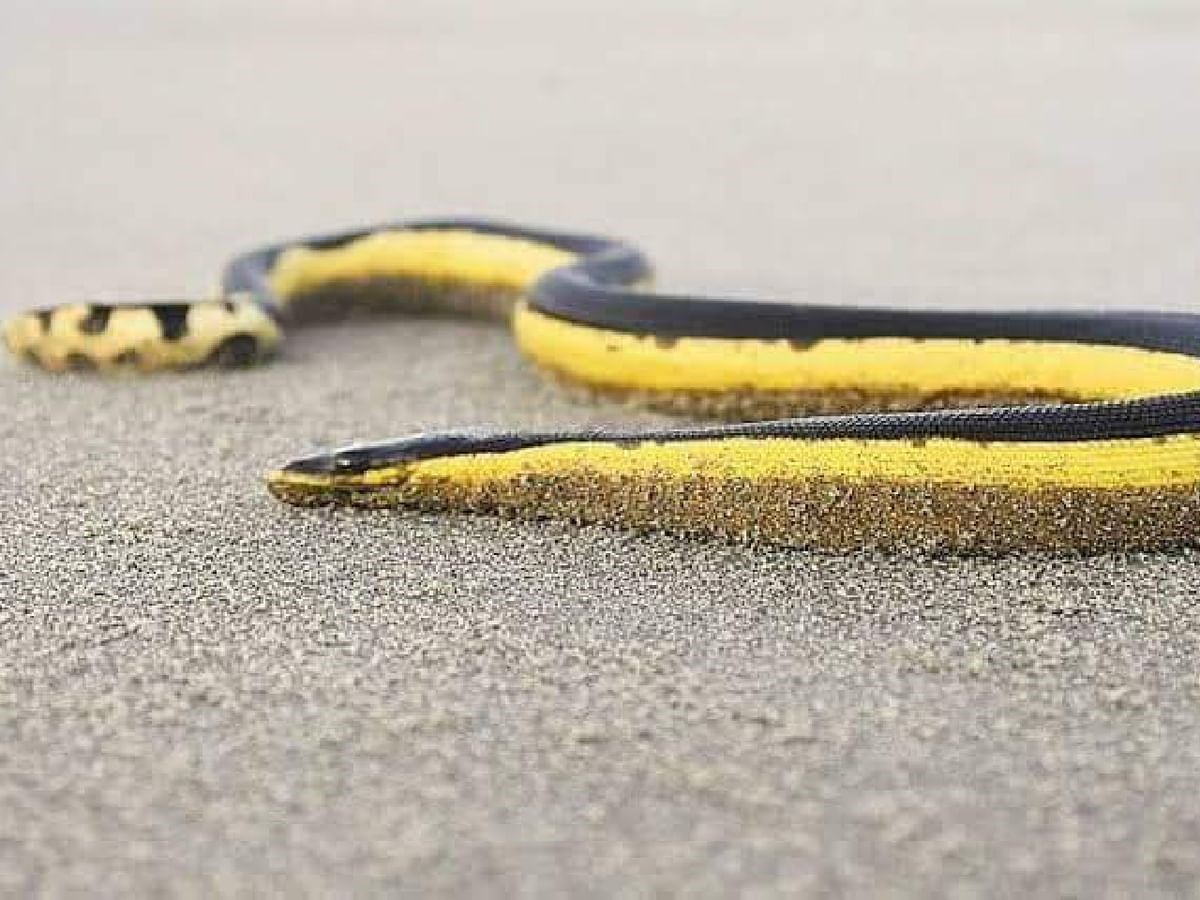Description

Disclaimer: Copyright infringement not intended.
Context
- A recent rare sighting of a yellow-belly snake in Digha, on the coast of the Bay of Bengal, has left experts and biologists puzzled.
Details
- This snake, known scientifically as 'Pelamis platurus,' is typically found in the Arabian Sea and is renowned for its highly poisonous venom.
Unusual Appearance
- The yellow-belly snake stands out from other reptile species due to its distinctive features.
- Its lower abdomen is colored yellow, giving it its common name, and the side of its tail resembles a boat's paddle.
- These characteristics make it easily identifiable when encountered.
Uncommon Venomous Sea Snake
- This particular sea snake is considered one of the most venomous in India.
- It possesses an extremely potent venom that can be life-threatening to humans.
- Experts warn that even antivenom treatments may not be effective against its poison.
- The intensity of the venom is so high that a person bitten by this snake may experience complete paralysis, leading to failure of the kidneys and heart, and the urine may turn coffee brown.
Unusual Migration to Bay of Bengal
- Biologists are intrigued by how this venomous snake, typically found in the Arabian Sea, made its way to the Bay of Bengal.
- The Bay of Bengal is not a known habitat for this species, making the sighting even more remarkable.
Threat to Fishermen
- While the yellow-belly snake is rarely spotted in the Bay of Bengal, its presence poses a significant threat to local fishermen.
- Some unreported cases of snake bites have resulted in fatalities, making it crucial to raise awareness among the fishing community about the potential risks.
Rare and Dangerous Encounter
- With only 24 types of sea snakes reported in India, the yellow belly found in Digha stands out as one of the most venomous among them.

Pelamis platurus
- Pelamis platurus, commonly known as the Yellow-Bellied Sea Snake or the Yellow Sea Snake, is a highly venomous sea snake belonging to the family Elapidae.
- This species is renowned for its striking appearance, potent venom, and unique adaptations to a marine lifestyle.
Physical Characteristics
- The Yellow-Bellied Sea Snake has a slender and elongated body, with adults typically ranging from 1 to 1.5 meters in length.
- Its dorsal coloration is typically black or dark brown, with distinctive yellow or light green lateral bands running along its sides, extending onto its belly.
- This vibrant coloration serves as a warning sign to potential predators, signaling its venomous nature.
Distribution and Habitat
- Pelamis platurus is widely distributed across the warm tropical and subtropical waters of the Indian and Pacific Oceans.
- Its range includes the coasts of Southeast Asia, northern Australia, Pacific islands, and parts of the western coast of Central and South America.
- Unlike most sea snakes that inhabit coastal waters and coral reefs, the Yellow-Bellied Sea Snake prefers open ocean environments, often found far from land.
- It is highly adapted to a pelagic (open sea) lifestyle and can be occasionally seen floating on the ocean surface or entangled in floating seaweed.
Adaptations to Marine Life
- Oar-like Tail: The snake's laterally compressed tail, resembling the shape of an oar or paddle, facilitates its movement in water. This adaptation allows the snake to navigate and propel itself with ease through the open ocean.
- Salt Glands: Like other sea snakes, Pelamis platurus possesses specialized salt glands that allow it to drink seawater and excrete excess salt. This adaptation enables it to survive in environments where freshwater is scarce.
- Viviparous Reproduction: Unlike most snakes that lay eggs, the Yellow-Bellied Sea Snake gives birth to live young. It is one of the few species of sea snakes that are viviparous, meaning the embryos develop inside the mother's body until they are ready to be born.
Venom and Predation
- The Yellow-Bellied Sea Snake is highly venomous and possesses potent neurotoxic venom.
- Its venom is primarily used to immobilize and kill its prey, which mainly consists of small fish and eels.
Conservation Status
- The conservation status of Pelamis platurus is categorized as "Least Concern" by the International Union for Conservation of Nature (IUCN).
- Its wide distribution and relatively stable population in its natural habitat contribute to this status.
- However, as with all wildlife, monitoring and conservation efforts are essential to ensure the ongoing survival of this unique and ecologically important sea snake.

Conclusion
- The rare sighting of the yellow-belly snake in the Bay of Bengal has sparked interest among experts and the public due to its venomous nature and unusual presence in the region. The need for further research, conservation, and awareness efforts becomes imperative to safeguard marine ecosystems and human lives from the potential threats posed by this rare and deadly snake species.
|
PRACTICE QUESTION
Q. Which of the following statements about Pelamis platurus, the Yellow-Bellied Sea Snake, is correct?
A) It is a non-venomous sea snake found in coastal waters and coral reefs.
B) It is primarily found in cold waters of the Atlantic Ocean.
C) Its venom is used to immobilize and kill its prey, which mainly consists of small fish and eels.
D) It lays eggs like most other snakes.
Answer: C) Its venom is used to immobilize and kill its prey, which mainly consists of small fish and eels.
|
https://www.news9live.com/india/most-poisonous-yellow-bellied-snake-found-in-bay-of-bengal-experts-say-snake-bite-can-paralyse-humans-2234771
















